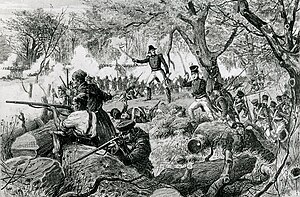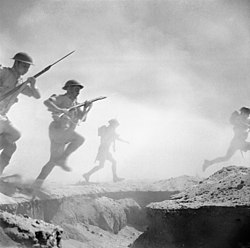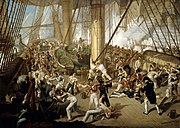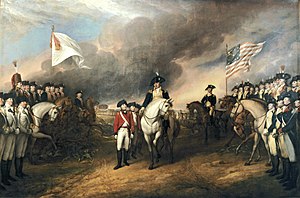This Day in History October 25th
October 25, 1415 The Battle of Agincourt
Henry V and his troops were marching to Calais to embark for England when he was intercepted by French forces which outnumbered his. English effectiveness and readiness was questionable as a result of their prior maneuvers consisting of an 18 day march across 250 miles of hostile territory under constant harassment. They suffered from dysentery and exhaustion, and were further hampered by inclement weather.
The battle was fought in the narrow strip of open land formed between the woods of Tramecourt and Agincourt (close to the modern village of Azincourt). The French army was positioned by d'Albret at the northern exit so as to bar the way to Calais. The night of 24 October was spent by the two armies on open ground.
Early on the 25th, Henry deployed his army (approximately 900 men-at-arms and 5,000 longbowmen, the latter commanded by Thomas Erpingham) across a 750 yard part of the defile. (It has been argued that fresh men were brought in after the siege of Harfleur; however, other historians argue that this is wrong, and that although 9,200 English left Harfleur, after a 250 mile march and more sickness had set in, they were down to roughly 5,900 by the time of the battle.) It is likely that the English adopted their usual battle line of longbowmen on either flank, men-at-arms and knights in the centre, and at the very centre roughly 200 archers. The English men-at-arms in plate and mail were placed shoulder to shoulder four deep. The English archers on the flanks drove pointed wooden stakes called palings into the ground at an angle to force cavalry to veer off.
On the morning of the 25th the French were still waiting for additional troops to arrive. The Duke of Brabant, the Duke of Anjou and the Duke of Brittany, each commanding 1,000–2,000 fighting men, were all marching to join the army. This left the French with a question of whether or not to advance towards the English.
For three hours after sunrise there was no fighting. The French, knowing that the English were trapped, and perhaps aware of their previous failures attacking English prepared positions, would not attack. Henry would have known as well as the French did that his army would perform better in a defensive battle, but he was eventually forced to take a calculated risk, and move his army further forward. This entailed pulling out the palings (long stakes pointed outwards toward the enemy) which protected the longbowmen, and abandoning his chosen position. (The use of palings was an innovation: during the battles of Crécy and Poitiers, two similar engagements between the French and the English, the archers did not use them.) If the French cavalry had charged before the palings had been hammered back in, the result would probably have been disastrous for the English, as it was at the Battle of Patay. However the French seem to have been caught off guard by the English advance. The tightness of the terrain also seems to have restricted the planned deployment of their forces. A battle plan had originally been drawn up which had archers and crossbowmen in front of the men-at-arms, with a cavalry force at the rear specifically designed to "fall upon the archers, and use their force to break them".[22] However in the event the archers and crossbowmen were deployed behind and to the sides of the men-at-arms, where they seem to have played almost no part in the battle, except possibly for an initial volley of arrows at the start of the battle. The cavalry force, which could have devastated the English line if it had attacked while they moved their position, only seems to have charged after the initial volley of arrows from the English. It is unclear if this is because the French were still hoping the English would launch a frontal assault themselves, or because they simply did not expect the English to advance at the exact moment they did. French chroniclers agree that when the mounted charge did come, it did not contain as many men as it should; Gilles le Bouvier states that some had wandered off to warm themselves and others were walking or feeding their horses.[23]
In any case, within extreme bowshot from the French line (approximately 300 yards), the longbowmen dug in their palings, and then opened the engagement with a barrage of arrows.
The French cavalry, despite being somewhat disorganised and not at full numbers, charged the longbowmen, but it was a disaster, with the French knights unable to outflank the longbowmen (because of the encroaching woodland) and unable to charge through the palings that protected the archers. Keegan (1976) argues that the longbows' main influence on the battle was at this point: only armoured on the head, many horses would have become dangerously out of control when struck in the back or flank from the high-elevation shots used as the charge started. The effect of the mounted charge and then retreat was to further churn up the mud the French had to cross to reach the English. Barker (2005) quotes a contemporary account by a monk of St. Denis who reports how the panicking horses also galloped back through the advancing infantry, scattering them and trampling them down in their headlong flight. The Burgundian sources similarly say that the mounted men-at-arms retreated back into the advancing French vanguard, "causing great disarray and breaking the line in many places".[24]
The constable himself led the attack of the dismounted French men-at-arms. French accounts describe their vanguard alone as containing about 5,000 men-at-arms, which would have outnumbered the English men-at-arms by about 5–1, but before they could engage in hand-to-hand fighting they had to cross the muddy field under a bombardment of arrows. The armour of the French men-at-arms is described by the Burgundian sources Le Fevre and Waurin as follows:
In addition, the French were so weighed down by armour that they could hardly move forward. First, they were armed with long coats of armour, stretching beyond their knees and being very heavy. Below these they had 'harnois de jambes' (leg armour) and above 'blans harnois ' (white i.e. polished armour). In addition they had 'bascinets de carvail'. So heavy were their arms that as the ground was so soft they could scarcely lift their weapons.[25]
Such heavy armour allowed them to close the 300 yards or so to the English lines while being under what the French monk of Saint Denis described as "a terrifying hail of arrow shot".[26] However they had to lower their visors and bend their heads to avoid being shot in the face (the eye and airholes in their helmets were some of the weakest points in the armour), which restricted both their breathing and their vision, and then they had to walk a few hundred yards through thick mud, wearing armour which weighed 50–60 pounds.[27]
The French men-at-arms reached the English line and actually pushed it back, with the longbowmen continuing to fire until they ran out of arrows and then dropping their bows and joining the melee (which lasted about three hours), implying that the French were able to walk through the fire of tens of thousands of arrows while taking comparatively few casualties. The physical pounding even from non-penetrating arrows, combined with the slog in heavy armour through the mud, the heat and lack of oxygen in plate armour with the visor down, and the crush of their numbers, meant they could "scarcely lift their weapons" when they finally engaged the English line however.
When the English archers, using hatchets, swords and other weapons, attacked the now disordered and fatigued French, the French could not cope with their unarmoured assailants (who were much less hindered by the mud). The exhausted French men-at-arms are described as being knocked to the ground and then unable to get back up. As the mêlée developed, the French second line also joined the attack, but they too were swallowed up, with the narrow terrain meaning the extra numbers could not be used effectively, and French men-at-arms were taken prisoner or killed in their thousands. The fighting lasted about three hours, but eventually the leaders of the second line were killed or captured, as those of the first line had been. The English Gesta Henrici describes three great heaps of the slain "which had risen above a man's height" around the three main English standards.[28]
One of the best anecdotes of the battle involves Humphrey, Duke of Gloucester, Henry V's youngest brother. According to the story, Henry, upon hearing that his brother had been wounded in the abdomen, took his household guard and cut a path through the French, standing over his brother and beating back waves of soldiers until Humphrey could be dragged to safety.
[edit] The assault on the baggage train and the killing of the prisoners
The only French success was a sally from Agincourt Castle behind the lines attacking the lightly protected English baggage train, with Ysembart d'Azincourt (leading a small number of men-at-arms and about 600 peasants) seizing some of Henry's personal treasures, including a crown. In some accounts this happened towards the end of the battle, and led the English to think they were being attacked from the rear. Barker (2005) prefers the Gesta Henrici however, believed to have been written by an English chaplain who was actually in the baggage train, who says that the attack happened at the start of the battle.
Regardless, there was definitely a point after the initial English victory where Henry became alarmed that the French were regrouping for another attack. The Gesta Henrici puts this after the English had overcome the onslaught of the French men-at-arms, and the weary English troops were eyeing the French rearguard ("in incomparable number and still fresh"). The Burgundian sources Le Fevre and Waurin similarly say that it was signs of the French rearguard regrouping and "marching forward in battle order" which made the English think they were still in danger.
In any event, Henry ordered the slaughter of what was perhaps several thousand French prisoners, with only the most illustrious being spared. His fear was that they would rearm themselves with the weapons strewn upon the field, and the exhausted English (who had been fighting for about three hours) would be overwhelmed. This was certainly ruthless, but arguably justifiable given the situation of the battle; perhaps surprisingly, even the French chroniclers do not criticise him for this.[29] This marked the end of the battle, as the French rearguard, having seen so many of the French nobility captured and killed, fled the battlefield.
[edit] Aftermath
Due to a lack of reliable sources it is impossible to give a precise figure for the French and English casualties. However, it is clear that though the English were considerably outnumbered, their losses were far lower than those of the French. The French sources all give 4,000–10,000 French dead, with up to 1,600 English dead. The lowest ratio in these French sources has the French losing six times more dead than the English. The English sources vary between about 1,500 and 11,000 for the French dead, with English dead put at no more than 100. The lowest ratio in the English sources has the French losing more than fifty times more dead than the English.[30]
Barker identifies from the available records "at least" 112 Englishmen who died in the fighting (including Edward of Norwich, 2nd Duke of York, a grandson of Edward III), but this excludes the wounded. One fairly widely used estimate puts the English casualties at 450, not an insignificant number in an army of 6,000, but far less than the thousands the French lost, nearly all of whom were killed or captured. Using the lowest French estimate of their own dead of 4,000 would imply a ratio of nearly 9–1 in favour of the English, or over 10–1 if the prisoners are included.
The French suffered heavily. The constable, three dukes, five counts and 90 barons all died. Estimates of the number of prisoners vary between 700 and 2,200, amongst them the Duke of Orléans (the famous poet Charles d'Orléans) and Jean Le Maingre, Marshal of France.

The Battle of Agincourt, 15th century miniature
October 25,1813 - Battle of Chateauguay (25th & 26th) War of 1812
In October of 1813, American Major General Wade Hampton marched his army from Lake Champlain down the Chateauguay River towards the St. Lawrence. This would serve as a feint in support of General Wilkinson’s main thrust against Kingston or, should Wilkinson switch his objective to Montreal, it would allow the two armies to combine on the shores of the St. Lawrence River.
On October 25, Hampton found his way blocked near Spears’ Farm by breastworks of abatis - a tangle of fresh-felled trees. This was the work of Canadian Voltigeurs under Lieutenant-Colonel Charles-Michel de Salaberry. From behind these primitive fortifications, de Salaberry hoped to stop Hampton’s advance.
Hampton judged the abatis too heavily defended to be taken by frontal assault. He grossly overestimated his opponents’ numbers at twice his own; in fact, he outnumbered them by about eight to one. He sent Colonel Robert Purdy with 1500 men on a sixteen mile overnight trek through the forest across the river to flank the Canadians.
After stumbling through the woods until after midnight, Purdy decided to wait for daylight before proceeding. In the morning, de Salaberry’s scouts detected his presence. Lieutenant Colonel “Red George” Macdonell, who’d been charged with guarding the Canadian rear, sent two companies of select embodied militia, including the Glengarry Light Infantry, to stop them. Purdy’s advance guard was just emerging from a cedar swamp when they stumbled into each other. Both sides opened fire. The Americans turned and ran. Several of them were then killed by the main body of Americans who mistook them for charging Canadians.
At two o’clock, Hampton’s main force attacked the abatis. Some of De Salaberry’s men spread out and sounded bugles simultaneously at different points in the forest, further fooling the Americans with regards to the size of their force. Mohawk warriors from Kahnawake, concealed among the trees, fired muskets and whooped loudly. The Americans, believing the bulk of the enemy were coming at them from that direction, fired volley after volley at nothing more than tree branches.
By then, Red George’s militiamen had made contact with Purdy’s detachment. The Americans fired a series of deadly volleys at them, but in the forest gloom, they failed to see that the Canadians were firing from a kneeling position. The American flew harmlessly over the Canadians. Meanwhile, Canadian muskets took a considerable toll on their enemy.
Purdy tried to outflank Red George’s men by skirting along the riverbank, but de Salaberry had anticipated that move and placed a detachment, muskets at the ready on the far bank of the narrow river. One volley was enough to send the Americans back inside the trees. Tired, wet, and believing themselves vastly outnumbered, the Americans had had enough. General Hampton ordered a general withdrawal.
For want of a decisive leader, the Americans had squandered another opportunity to win significant British territory. De Salaberry complained bitterly that Sir George Prevost and General de Watteville, who never came near the action, took most of the credit for themselves.

Bataille de la Chateauguay by Henri Julien. Lithograph from Le Journal de Dimanche, 1884.
October 25, 1854 Battle of Balaklava in the Crimean War
The battle started with a successful Russian attack on Ottoman positions. After holding out against the Russians, the Turks were either killed or were forced to retreat from their redoubts.This allowed the Russians to break through into the valley of Balaclava, where British forces were encamped. The port of Balaclava, a short distance to the south, was the site of a key British supply base. The Russian advance was intended to disrupt the British base and attack British positions near Sevastopol from the rear.
An initial Russian advance south of the southern line of hills was repulsed by the British. A large attacking force of Russian cavalry advanced over the ridgeline, and split into two portions. One of these columns drove south towards the town of Balaclava itself, threatening the main supply of the entire British army. That drive was repulsed by the muskets of the 93rd (Highland) Regiment and the now-reformed Turks. Forming a lone line of two rows by its commander,Sir Colin Campbell, they were able to deceisively halt the Russian advance. This action became known in history as "The Thin Red Line".
The second column of Russian cavalry was then met by the British Heavy Brigade, in an uphill charge that defied conventional military logic. This action by the British cavalry forced the Russians to retreat to their artillery, which was strategically positioned along the ridges above the valley. At this point, Raglan ordered the Light Brigade to "prevent the enemy carrying away the guns", in a written order delivered by Captain Nolan. Though the following events are somewhat unclear, it is generally accepted that Nolan was aware that Lord Raglan had intended for the Light Brigade to charge the captured British guns that were being carried off the redoubt by the Russians. According to contemporary accounts, Nolan delivered the written order in haste while verbally indicating to Lord Cardigan that he should direct an assault upon the Russian gun battery that was down the valley. This action resulted in what would come to be known as the Charge of the Light Brigade. After its initial charge was repulsed, the Light Brigade was saved from further casualties by a supporting attack from the French 4th Chasseurs d'Afrique.
The battle ended inconclusively, with both sides retaining their starting positions. Aleksandr Sergeyevich Menshikov, the Russian commander, later claimed success, saying the attack was only a probe to gauge allied defence.










